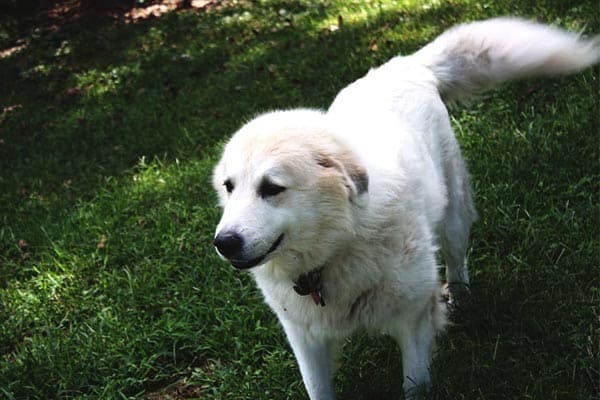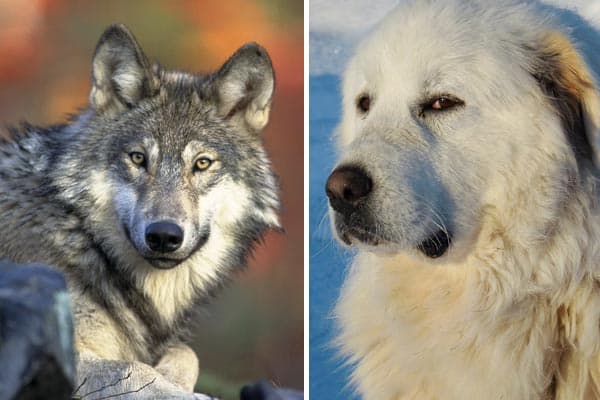Do Great Pyrenees Shed: What You Need to Know About the Great Pyrenees Coat

The Great Pyrenees dog breed is a truly ancient, noble, and beloved dog breed that many owners and breeders have nicknamed a “gentle giant.”
This dog is loving and loyal, great with kids and other family pets, and make amazing therapy and service dogs.
But there is one potential drawback to choosing a Great Pyrenees – their coat. In this article, we answer the question so many prospective dog owners are asking. “Do Great Pyrenees shed?”
Read on now and find out what you need to know about the Great Pyrenees coat.
Do Great Pyrenees Shed?
Do Great Pyrenees dogs shed? Yes, they do. They shed all year long and sometimes they shed profusely. Ask any Great Pyrenees owner about their enormous dog’s thick, shaggy, double-layer coat and whether it sheds, and you are likely to get a long list of coat control product recommendations, including brushes, combs, a de-lint brush, and a vacuum cleaner.
The Great Pyrenees is a wonderful dog breed in many ways. But this definitely isn’t the dog for you if you are sensitive to pet dander or have pet allergies.
Watch a Great Pyrenees Get Groomed
In this short video from a professional dog groomer, you can hear more about the Great Pyrenees’ thick, double-layer coat and watch a Great Pyrenees dog get groomed.
You will notice that the groomer in the video has a great many grooming and brushing tools that she uses on Maggie, the Great Pyrenees dog.
Even if you plan to take your Great Pyrenees to a professional groomer, you may want to invest in some of these tools for home use as well. This can help control how much dead, shed hair you have to sweep and vacuum up and also keep your dog’s coat healthy.
Get the Inside Scoop on Great Pyrenees Shedding
As the Great Pyrenees Club of America recounts, the Great Pyrenees is truly an ancient dog breed.
Canine biologists have traced the origin of this dog breed back at least 11,000 years to a part of the world that today is called Turkey.
Great Pyrenees are true working dogs
These dogs were originally bred to herd and guard sheep. Their dense, double layer white coat is a hallmark of the breed in every way.
For pet Great Pyrenees dogs today, the coat often seems to be more of a hassle than a help. But back in the days when these dogs were true working dogs that stood guard 24/7 over their livestock charges, that same coat was a lifesaver.
Why is the Great Pyrenees coat double layers?
The coat is a double layer, with a coarser, longer, water-resistant outer layer, and a thick, soft and densely insulating under layer.
As you might imagine, this type of coat kept the dog warm and dry while working out in the elements every season.
Why does the Great Pyrenees shed so much?
This is also why the Great Pyrenees sheds heavily year-round and very heavily seasonally. The coat is the dog’s primary protection against the elements and to do its job well, the hairs need to be healthy and sturdy.
As the coat goes through wear and tear seasonally, it doesn’t do its job as well. Shedding out dead hair helps replenish the protective properties of the dog’s coat.
What is the “coat blow?”
In the transition to the warm season, a great portion of the insulating undercoat will naturally shed out so the dog doesn’t overheat while working outdoors.
Similarly, in the transition to the cool season, the summer coat will shed out and the thicker winter coat will grow in.
These seasonal sheds are called “coat blows” because it can literally feel like you are surrounded by dead, shed dog hair day in and day out until the transition period has concluded.
Learn About the Stages of the Great Pyrenees Coat: From Puppy to Adult
It is natural and smart to be curious about what your Great Pyrenees’ coat will be like in puppyhood, adolescence, and adulthood.
You already know that your dog will shed, and sometimes quite a lot!
But when will that begin? How long will it take for your dog’s full adult coat to grow in? Is there anything special you need to know about the puppy, adolescent, or adult Great Pyrenees coat? Let’s find out.
Great Pyrenees dog breed standard: coat type
According to the Great Pyrenees Rescue Society, the breed standard specifies that the adult Great Pyrenees coat will conform to the following attributes:
- Coarse, flat, thick outer layer.
- The seasonal undercoat of fine, woolly texture.
- Undercoat traditionally sheds out in the spring.
- Male dog coats are thicker with more of a neck and shoulder “ruff.”
- The coat type should be flat and straight or only slightly wavy.
- The main coat color is white but may have some markings on the face and body.
- The undercoat color is either white or has a shade to it.
Timeline for the transition from puppy to adolescent to adult coat
It is important to remember that each dog is going to be somewhat different. So you can look at this timeline as more of a guideline than a set of hard and fast rules.
If your Great Pyrenees puppy doesn’t seem to be following this timeline at all, it is always smart to reach out to your breeder or your canine veterinarian with any questions.
With that said, let’s dive in and learn more about the Great Pyrenees coat timeline from puppyhood to adulthood.
Birth to four to six months or longer
As the American Kennel Club (AKC) points out, because the Great Pyrenees is a giant breed dog, the growth timeline is quite a bit slower than it would be for a small breed dog.
This means that you may see your Great Pyrenees start shedding out their puppy coat anywhere from four to 12 months of age.
The puppy coat is generally quite fluffy, which is how most Great Pyrenees puppy owners tend to describe it.
This adorable puppy coat fluff is a single-layer coat, which is a big part of the reason it tends to stick up more and make your dog look like a cotton ball on legs.
But in general, six months is around the time when you may see some of that puppy fluff start shedding out with a slightly thicker and coarser adolescent coat growing in its place.
The signal you are most likely to see is a period when your puppy sort of seems to be having “coat growing pains.” So you might see that the coat is shorter and fluffier in certain sections and longer and fuller in other sections for a time.
Six to 12 months or longer
According to the Great Pyrenees Resource owner forum, some Great Pyrenees puppies may fully lose their puppy coat by the age of 12 months.
This may mean your puppy has lost 100 percent of their puppy coat and is in a full adolescent coat around the age of one-year-old.
It may also mean that your puppy has the full adolescent coat and is starting the transition to the full adult coat.
The adolescent coat is going to be a mid-point between the single-layer puppy coat and the full double-layer adult coat.
One thing to keep in mind is that as long as the coat is in transition, you can count on seeing a lot of shedding and doing a lot of sweeping. Which is great, because you will get used to that routine right away and be able to set up your grooming routine.
12 months to two years or longer
In most cases, a Great Pyrenees puppy will start the transition away from the adolescent coat to the adult coat around the age of 12 months old.
The adolescent coat can take up to another full year to grow in, which means another year of periodic intense shedding.
Special Shedding Issues to Watch For in the Great Pyrenees
By the age of 24 months, the majority of the full adult double layer coat is typically grown in. This will be the point at which the regular adult shedding with the seasonal “coat blow” sheds will kick in.
This is also when your dog’s shedding cycles will become more regular, which is helpful to know in case your adult dog’s coat seems to be shedding profusely out of season or shedding in a spotty pattern that you aren’t used to seeing.
These types of erratic or unusual shedding patterns may be an indicator of an underlying health problem.
According to All Fur Paws Animal Hospital, the Great Pyrenees breed has a greater tendency to suffer from certain health issues, including the following:
– Skin atopy (especially on feet, belly, skin folds, ears).
– Ear infections.
– Hypoadrenocorticism (Addison’s).
These issues can manifest with abnormal shedding, scaly or red skin, or signs that your dog is uncomfortable such as ear rubbing, biting at paws, or repetitive biting or scratching at areas on the skin.
How to Groom a Great Pyrenees to Minimize Shedding
As Housman Great Pyrenees breeder explains, the main type of coat maintenance that Great Pyrenees need from is always going to be brushing the coat.
Luckily, even though your dog is going to shed a lot throughout life, the coat is somewhat self-maintaining in terms of resisting mats and tangles.
If you are caring for a Great Pyrenees puppy, it can be a process to get your puppy used to being brushed and groomed. Your puppy will likely be more interested in playing with the brush than in being brushed with it.
By keeping brushing sessions short and filled with praise and treats, you can gradually increase the brushing time as your puppy’s tolerance grows.
The breeder states that the adult male coat tends to be thicker and fuller than the adult female coat. But in general, you can plan on brushing your dog’s coat for about one-half hour to 45 minutes at least once to twice per week.
This will not only keep your dog’s beautiful white coat looking great and functioning well, but it will also alert you to any coat or skin issues you might otherwise not have noticed.
And it will help to minimize the amount of dead, shed hair that falls off your dog and lands on you, your furniture and the floor.
Is It Okay to Shave Your Great Pyrenees?
The National Pyr Rescue charity states that the only time you should consider shaving your Great Pyrenees is if the coat has gotten too tangled and matted to be brushed out.
While the Great Pyrenees coat is designed to naturally repel tangles and mats if neglected these problems can absolutely develop in the coat.
If it gets to the point where it will cause your dog too much discomfort and pain to try to work out the tangles and mats with a comb, then shaving is the most humane as well as the safest option.
Otherwise, you never want to shave a double-coated dog’s coat. Once you shave the coat, it will not grow back in with the same protective properties as before.
Ordinarily, the two layers – outer water-resistant layer and inner insulating layer – grow in separately and stay separate. But after being shaved, the two layers will grow in together and intermix.
This drastically reduces the insulating property of the inner coat layer and the water-resisting ability of the outer layer. In many cases, the coat will never again grow properly in the way that nature designed.
The Great Pyrenees is an amazing family dog and watchdog for the right person who doesn’t mind regular brushing and sweeping shed dog hair!





